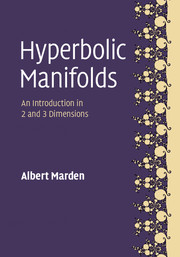Book contents
- Frontmatter
- Dedication
- Contents
- List of Illustrations
- Preface
- 1 Hyperbolic space and its isometries
- 2 Discrete groups
- 3 Properties of hyperbolic manifolds
- 4 Algebraic and geometric convergence
- 5 Deformation spaces and the ends of manifolds
- 6 Hyperbolization
- 7 Line geometry
- 8 Right hexagons and hyperbolic trigonometry
- Bibliography
- Index
6 - Hyperbolization
Published online by Cambridge University Press: 05 January 2016
- Frontmatter
- Dedication
- Contents
- List of Illustrations
- Preface
- 1 Hyperbolic space and its isometries
- 2 Discrete groups
- 3 Properties of hyperbolic manifolds
- 4 Algebraic and geometric convergence
- 5 Deformation spaces and the ends of manifolds
- 6 Hyperbolization
- 7 Line geometry
- 8 Right hexagons and hyperbolic trigonometry
- Bibliography
- Index
Summary
The focus of this chapter is the Hyperbolization Theorem for essentially compact 3-manifolds, one of the most influential mathematical discoveries of the twentieth century, and one for the ages. This theorem shows that the interiors of “most” of these 3-manifolds, in particular most knot and link complements, can be realized as kleinian manifolds. As a consequence, such 3-manifolds can be described and classified not just in terms of their topology, but more powerfully, in terms of their geometrical properties—shape and volume.
We will continue on with a presentation of the recent profound discoveries concerning the structure of closed hyperbolic manifolds. In particular, each contains infinitely many essential immersed surfaces, and has a finite-sheeted cover which fibers over the circle.
Hyperbolic manifolds that fiber over a circle
Automorphisms of surfaces
We begin by reviewing some facts about automorphisms (orientation-preserving selfhomeomorphisms) of hyperbolic surfaces, but not the 3-punctured sphere. We will continue using as basepoint a fuchsian group G and associated hyperbolic Riemann surfaces R = LHP/G, R’ = UHP/G, closed with at most a finite number of punctures. Suppose α : R → R is an orientation-preserving automorphism which is not homotopic to the identity. As we learned in Section 5.5.1, the automorphism α, or rather its homotopy/isotopy class, induces an automorphism of the Bers slice B(R) ≡ Teich(R) based on R, which we also denote by α, by the action
Here J, J2 ∼ 1 is a fiber-preserving reflection of M(R) with J : R ↔ R’. The identity automorphism of R is sent to the automorphism J ◦ α ◦ J of R’ which does not change conformal type of R’. Instead the relationship between R and R’ changes (since α is not homotopic to the identity). The group of homotopy classes of orientation-preserving automorphisms α is called the mapping class group or Teichmüller modular group. It is the group of all isometries of Teichmüller space Teich(R) in the Teichmüller metric of Section 2.8.
Pseudo-Anosov mappings
Recall from Exercise (5-12) that a pseudo-Anosov automorphism is a homeomorphism α of a surface R onto itself with these properties: (i) No power αn is homotopic to the identity; and (ii) α does not preserve the set of free homotopy classes of any system of mutually disjoint, simple geodesics on R. Such automorphisms of R are the “generic” automorphisms.
- Type
- Chapter
- Information
- Hyperbolic ManifoldsAn Introduction in 2 and 3 Dimensions, pp. 371 - 424Publisher: Cambridge University PressPrint publication year: 2016



